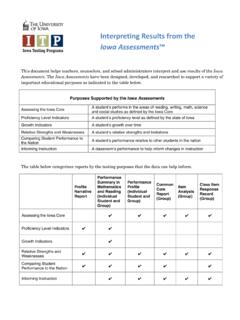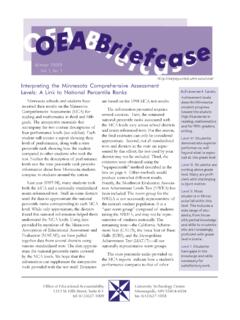Transcription of COGNITIVE ABILITIES TEST - GL Education
1 TEACHER. G U I D A N C E PA C K. COGNITIVE . ABILITIES . TEST. D A V I D F. L O H M A N , U N I V E R S I T Y O F I O W A. PA U L I N E S M I T H , G L A S S E S S M E N T. Contents Introduction to CAT4. Administration Instructions: Paper Edition Administration Instructions: Digital Edition Guidance on scoring and reporting results Case studies Technical information Appendices Appendix A CAT4 Time Chart Appendix B Sample letters Appendix C Articles of interest to CAT4 users Appendix D Group Header Sheet Miscellaneous CATAS ( COGNITIVE ABILITIES Test Attitudinal Survey). Copyright 2012 GL Assessment Limited Page i GL Assessment wishes to thank all those who have contributed to the publication of CAT4. In particular, we would like to acknowledge the commitment of all the schools and students who took part in pre-trialling, trialling and standardisation activities, without whom this project would not have been possible.
2 GL Assessment Publishing and Production team Andrew Thraves, Publishing and Strategy Director Sue Thompson, Senior Publisher Pauline Smith, Senior Psychometric Consultant Cres Fernandes, Head of Statistics Natalie Cook, Production Manager Jo Eggeman, Project Manager Lumi re Chieh, Production Editor Philippa Reddington, Editorial and Production Co-ordinator School liaison Rachel Watts, Data Services Manager Report development Jenny Featherston, Business Solutions Analyst Ian Helm, Senior Project Manager Amanda Power, Head of Assessment Services Technical development Paul Webster, Operations Director Phil Shrimpton, Head of Development Stu Cairns, Senior Developer Neil Parvin, Senior Project Manager Jon Wilkins, Savenet, Developer The Riverside Publishing Company We are grateful to colleagues at The Riverside Publishing Company who have aided in the content development of CAT4.
3 Page ii Acknowledgments Introduction to CAT4. What is CAT4? The COGNITIVE ABILITIES Test Fourth Edition (CAT4) is a suite of tests developed to support schools in understanding students' ABILITIES and likely academic potential. Results from CAT4 can be used to inform individual and group teaching, for target setting and monitoring the performance of groups of students. CAT4 assesses the ability to reason with and manipulate different types of material. CAT4 comprises four batteries of tests that assess CAT4 assesses the main types of mental processing which play a substantial role in the ability to human thought. Together, these four batteries provide users with a reason with comprehensive understanding of the core ABILITIES related to learning and manipulate by assessing a student's capabilities when dealing with each type different types of processing.
4 Of material. The CAT4 batteries therefore assess: s reasoning with words s reasoning with numbers s reasoning with shapes and designs s thinking with and mentally manipulating precise shapes. The set of four scores obtained from assessment with CAT4 provides a pro le of a student's level and pattern of ABILITIES , as well as providing an overall summary score of his or her reasoning ABILITIES across the four areas. CAT4 is available in both paper and digital editions. The test content of each is identical. Administration instructions for both editions are contained in this pack. Details of scoring and reporting services for schools using both the paper and digital editions of CAT4 are set out in the section entitled Guidance on scoring and reporting results' in this pack.
5 During the development of CAT4, the authors have emphasised the assessment of relational thinking; that is, the ability to understand relationships among elements using the media of the four test batteries. As with the previous edition, CAT3, the basic elements of each test have been kept simple and clear to ensure the tests are accessible to students of the appropriate age for each test level. The tests are therefore appropriate for use with all students who have been educated in the UK. and exposed to modern cultural in uences. Copyright 2012 GL Assessment Limited Page 1. INTRODUCTION. Why a fourth edition? The fourth edition of CAT was developed for two main reasons. s First, as CAT3 was standardised in 2000, it was necessary to restandardise it so that the normative data accurately re ect the current ABILITIES of students.
6 S The second reason was to further develop the structure of the CAT4. batteries in accordance with established research on the importance of spatial ABILITIES . As a result, CAT4 includes a new Spatial Ability Battery. This battery includes one of the tests from the CAT3. Non-verbal Reasoning Battery plus a new test developed speci cally for CAT4. This development further sharpens the understanding of students' non-verbal and spatial ABILITIES by ensuring each battery is a purer measure of what it is intended to assess. More on the Spatial Ability and Non-verbal Reasoning Batteries The Spatial Ability Battery is designed to assess how well students Students with can create and retain mental images of precise shapes and objects, a high spatial and then manipulate these in their minds.
7 This ability is critical to ability may be effective working in many spatial' disciplines and careers (for example well-suited to jobs engineering, physical sciences, mathematics and architecture). Yet it involving visual has traditionally been under-appreciated or under-assessed in schools, either being ignored completely or viewed as relevant only to low-level'. mapping such manual skills. as architecture, graphic design, For this reason, students who excel in such thinking have been photography and under-identi ed and therefore not properly encouraged to actualise astronomy. their potential. Perhaps as a consequence, spatial disciplines have struggled to obtain enough recruits and those that they do recruit have sometimes not been best suited to the demands of the work, having been chosen on the basis of inappropriate ability measures, family pressure or gender-stereotyping for example, engineering is a man's job'.
8 In recent decades, major longitudinal research projects have conclusively shown that spatial ability is a signi cant element underlying performance in spatial disciplines. Also, it has been found that those who are most likely to pursue and excel in these domains are people with a relative strength in spatial ability, rather than necessarily those who do well in all types of ability test. The balance of ABILITIES even a small difference within a person who has a very high level of general ability seems critical for career choice and success. Assessing people solely on verbal and mathematical tests is therefore likely to miss many of those with the highest potential to succeed in spatial careers. Such research is presented succinctly in the article Recognizing Spatial Intelligence (Park et al.)
9 , Scienti c AmericanTM, November 2010). Page 2 Introduction INTRODUCTION. The short article, reproduced in full in Appendix C of this pack, concludes: Due to the neglect of spatial ability in school curricula, traditional standardized assessments, and in national talent searches, those with relative spatial strengths across the entire range of ability constitute an under-served population with potential to bolster the current scienti c and technical workforce. The Non-verbal Reasoning Battery is designed to measure something distinct from the Spatial Ability Battery. The materials used are still The Non-verbal shapes but the dif culty of the task lies not in creating, maintaining Reasoning Battery and mentally manipulating precise images but in reasoning with easily is designed distinguishable shapes and designs.
10 Like the Verbal and Quantitative to measure Reasoning Batteries, it measures basic reasoning processes such as something distinct identifying similarities and relationships but using shapes and designs rather than words or numbers as the stimulus material. For this reason, from the Spatial it provides a means by which those with a spatial bias can demonstrate Ability Battery. how effectively they can engage in general reasoning processes. However, the fact that the shapes and designs used are easy to distinguish means that those with a verbal bias can also succeed on the non-verbal items, by describing the shapes and designs in words and then reasoning out the solution verbally for example, large circle goes to small circle and two horizontal lines are added'.


